It wasn’t long ago when shellfish bed closures inspired people to take action to clean up Buzzards Bay. Today, our beaches are cleaner and more shellfishing areas are open because less bacteria pollutes our waterways. But bacterial contamination is still a threat to many places around the Bay where people swim and shellfish.
Where does bacteria come from?
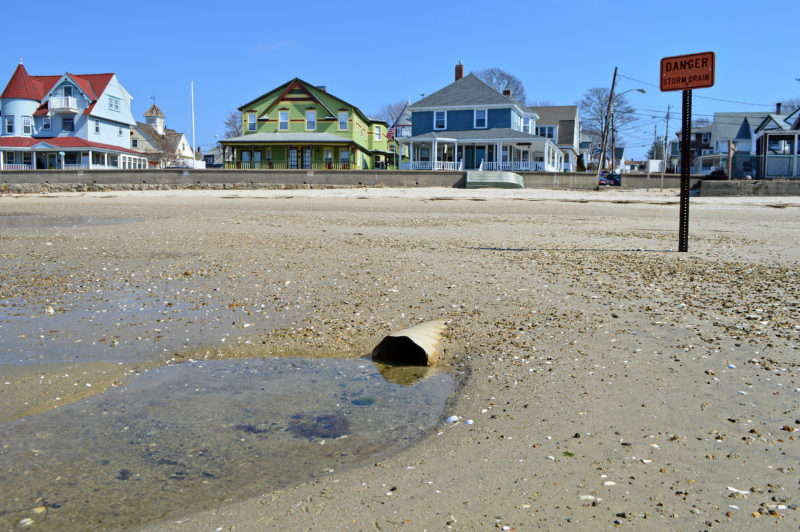
Stormwater pipes, like this one at a beach in Onset, discharge polluted runoff from nearby streets directly into the water.
Bacteria comes from human sewage and animal waste. When these aren’t properly treated or disposed of, bacteria like fecal coliform, E. coli, and enterococci can contaminate our local waterways.
The largest source of bacterial contamination in Buzzards Bay is polluted stormwater runoff. Other sources, like illegal boat sewage discharges and New Bedford’s Combined Sewer Overflows (CSOs), can lead to contamination in local areas around the Bay.
Polluted stormwater runoff
All around Buzzards Bay, thousands of stormwater pipes discharge polluted runoff into our harbors, coves, and rivers. Every time it rains, these pipes collect runoff from your community and send it directly into the nearest waterway. With that runoff comes pollution, including bacteria.
There are many sources of bacteria in stormwater. Failing home septic systems are likely a large cause; when septic systems fail, untreated sewage can seep above ground and leak into the nearest storm drain. Dog waste that’s left on the ground is another source.
Combined Sewer Overflows (CSOs) in New Bedford
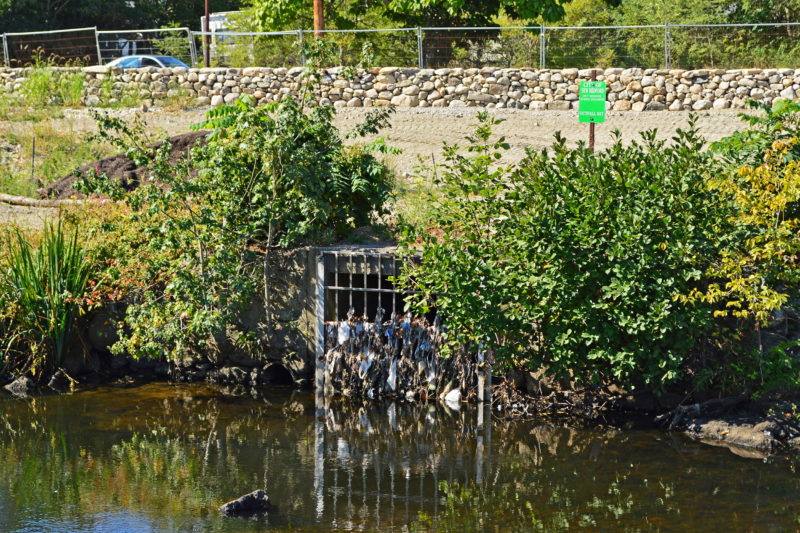
During heavy rainstorms, raw sewage gets discharged directly into the Acushnet River and New Bedford Harbor through pipes called combined sewer overflows (CSOs), like this one at The Sawmill in Acushnet.
Like many older cities, New Bedford’s wastewater system combines sewers and stormwater into a single pipe. During heavy rainstorms, the city’s wastewater treatment plant can’t handle such a large volume of combined flow. So raw sewage gets discharged directly into New Bedford Harbor through pipes called combined sewer overflows (CSOs).
New Bedford has been working hard to eliminate CSOs – since 1990, the city has decreased total annual sewage discharges by 95%. As a result, some shellfish beds have slowly begun to reopen in Clarks Cove and outer New Bedford Harbor. But as long as there are any CSOs left in New Bedford, these pipes will continue to be a significant source of bacterial contamination in the city’s local waters.
Illegal boat sewage discharges
Buzzards Bay is a No Discharge Zone, which means it’s illegal to discharge boat waste anywhere in the Bay. With thousands of boats on Buzzards Bay, it’s important to educate boaters to prevent illegal sewage discharges.
Two dozen locations around Buzzards Bay offer pumpout services to boaters. One of these is on Cuttyhunk Harbor, where the Coalition offers free pumpouts every summer. We’re currently working to bring a permanent pumpout service to the island.
How does bacterial contamination harm Buzzards Bay?
Bacterial contamination poses a serious risk to our health, as well as to the economy around Buzzards Bay. When bacteria pollute our waterways, we can’t swim or eat shellfish caught there. For people who depend on shellfishing and tourism for their livelihood, bacteria is a big problem.
Health officials closely monitor bacteria levels in our local waters. When these levels exceed public health standards, towns and cities close their local swimming beaches and shellfish beds. Many of these closures are temporary – after a rainstorm, for instance – whereas others are permanent.
Shellfish bed closures
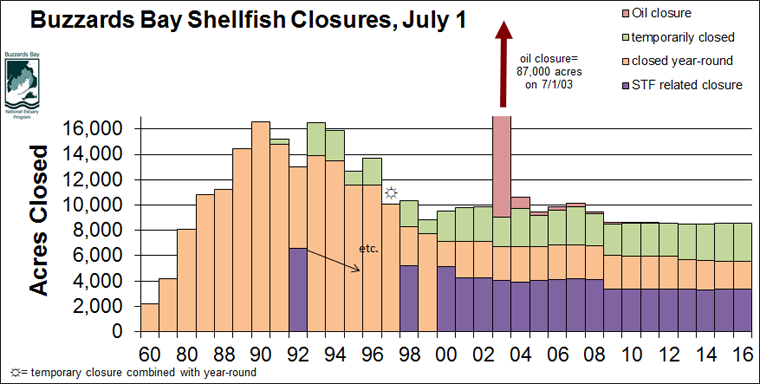
By 1990, more than 16,000 acres of shellfish beds were closed in Buzzards Bay. Half of those have reopened, but there are still too many shellfishing areas closed because of bacterial contamination. (Click graph to view larger version)
Shellfish bed closures in Buzzards Bay began to climb in the 1960s. The region’s population was growing, and sprawling residential development started paving larger swaths of the land. In 1970, roughly 4,000 acres of shellfish beds were closed, mostly near large wastewater discharges. By 1990, that amount quadrupled.
These closures worried local residents. In the 1980s, concerned members of the public rallied around the cause of clean water in Buzzards Bay, which led to the formation of the Coalition in 1987.
Today, shellfish bed closures have been cut in half from their peak in 1990. However, there are still three times as many permanently closed shellfish beds now than there were in 1960.
Beach closures
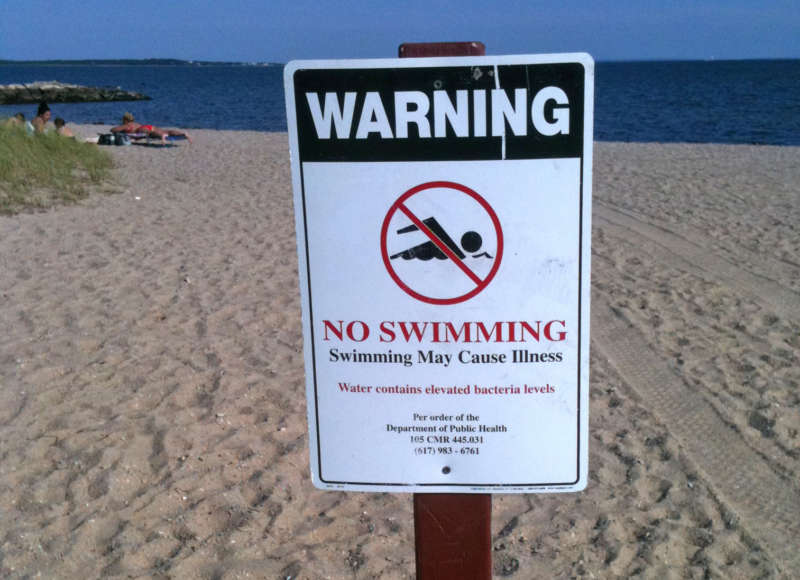
Have you ever seen a beach closed to swimming the day after a summer rainstorm? That’s because of bacterial contamination from polluted stormwater runoff.
Have you ever seen a beach closed to swimming the day after a summer rainstorm? That’s because of bacterial contamination from polluted stormwater runoff. It pours into storm drains, through underground pipes, and into our waterways – often right near our favorite beaches.
Most of Buzzards Bay’s beaches are clean and safe to swim. But some beaches near rivers, salt marsh channels, stormwater pipes, and CSOs can have high levels of bacterial contamination after heavy rainstorms. To avoid harmful bacteria, keep an eye out for beach closure notices after heavy rainstorms.
What’s being done to stop bacterial contamination?
Bacterial contamination was once Buzzards Bay’s biggest pollution problem. To fix this, communities around the Bay have been working for decades to improve wastewater treatment, correct stormwater discharges, identify illegal septic system hookups, and tie more homes to municipal wastewater plants. As a result, our beaches are now safer and more shellfish beds are open.
These improvements are something to celebrate – but we still have a long way to go. Twenty-two of the Bay’s major harbors and coves are listed as impaired due to bacteria. And nearly 40% of our shellfish beds are still permanently closed.
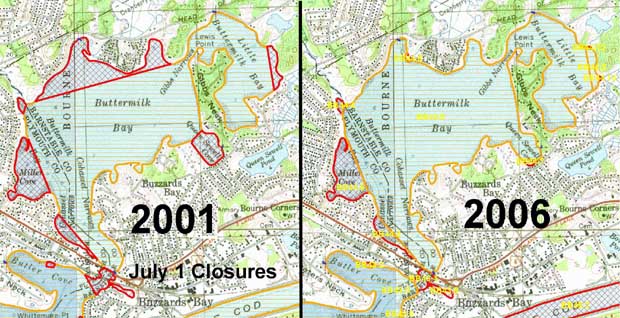
In Buttermilk Bay in Bourne, shellfish beds have slowly reopened. The areas in red show closed shellfishing areas. (Click map to view larger version)
It’s critical that communities continue to tackle the major sources of bacterial contamination in Buzzards Bay, like polluted stormwater runoff. Some towns and landowners are adding low-impact development techniques like rain gardens, porous pavement, and vegetated roofs. These green features mimic nature to reduce stormwater runoff. Conserving land also helps protect more forests, fields, and wetlands that absorb polluted runoff.
We also support the city of New Bedford in its efforts to eliminate all CSOs that send raw sewage to New Bedford Harbor and the Acushnet River. These outdated overflows have no place in a clean, healthy Buzzards Bay.
As long as there are closed beaches and shellfish beds on Buzzards Bay, the Coalition will continue to help communities get rid of sources of bacterial contamination.